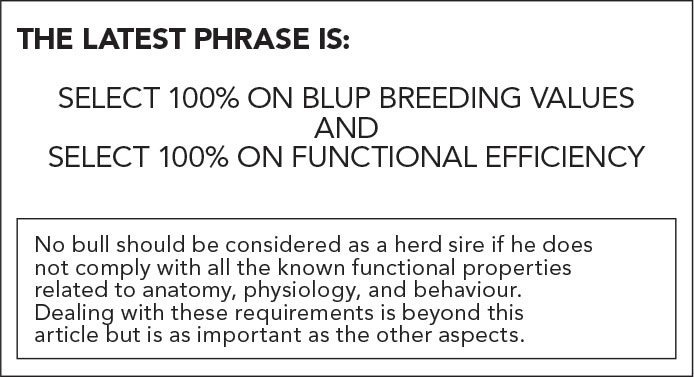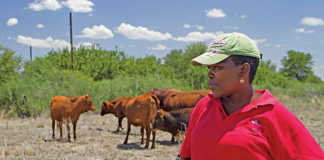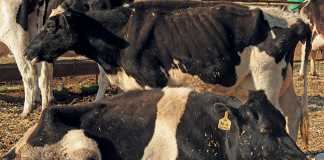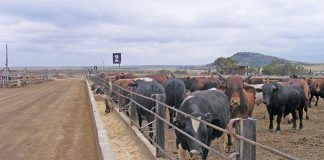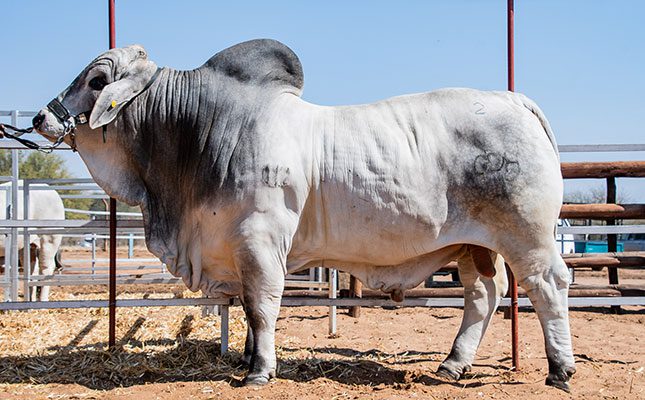
Photo: FW Archive
Any genuine scholar of animal breeding will know how to distinguish between records and objectives, and how to optimally use them.
Some people tend to confuse recording (and the resultant prediction of genetic merit) with breeding objectives, and even mating plans.
Figure 1 illustrates the differences among breeding objectives, selection based on genetic merit and mating plans.
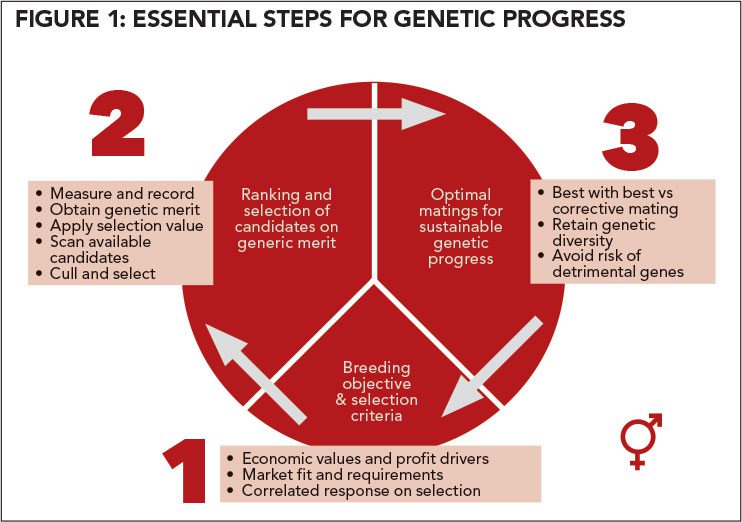
Selection has no purpose unless a proper breeding objective is formulated and pursued. Such an objective must be built on the individual relative economic contributions of each of the measurable traits and properties considered for measurement and recording.
Market forces and price structures should play a major role, but other profit drivers, such as biological efficiency and expected correlated responses of selection, should also be considered.
This should then result in the drafting of selection indices and other selection criteria to consider selection candidates (to be the parents of the next generation).
There is no compromise for accurate and thorough measurement, assessment and recording of the traits contributing towards the breeding objective. All proper genetic merit predictions rely on proper recording.
The next very important step in attaining the objectives is to rank all selection candidates on their genetic merit for the selection indices stemming from the objective, and to cull those not fitting to be parents for the next generation.
READ Boosting dairy profitability: it’s not all in the genes!
This step also involves the scanning of the wider population (breed), especially for males that can accelerate the pace to achieve the objective. The last important step is to use optimal matings in order to achieve the objective and to ensure sustainability of selection.
Usually, the pace of genetic gain is maximised by mating the best selection candidates and culling the rest, but sometimes, like when using corrective mating, compromises must be made.
Genetic diversity is also key to sustainable goal achievement and is only possible when inbreeding levels are maintained as low as possible. Proper mating plans should also mitigate the risk of increasing the frequency of deleterious forms (alleles) of genes (or increase wanted alleles).
Continuous assessment and benchmarking might lead to adaptations in breeding goals and objectives. This flexibility should, however, not lead to drastic changes on a regular basis, as annual genetic progress of beef cattle is generally slow due to the limitation of a relative long generation interval.
Making the right choices
Table 1 gives a brief summary of the selection and breeding choices faced by the beef producer, both in a stud and commercial setting.
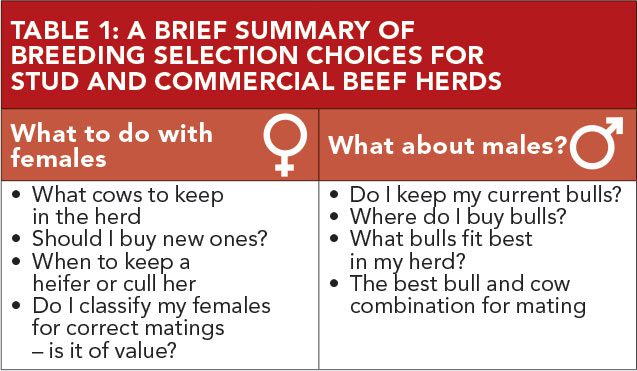
All beef cattle owners are confronted with making choices with the available genetic resources to ensure a sustainable business.
The most important resources are the currently reproducing cows and the available heifers to replace the less productive mature cows. The most important choice is which cows to cull and whether to replace them with other cows or with young, selected heifers.
When deciding on which bulls to use, the breeder must firstly know the strong and weak points of his cowherd, or of groups of cows within the herd. It is also important to take into account the previous usage of the currently available bulls within the herd.
Regular replacement ensures that genetic diversity and the ability to continuously apply selection pressure is possible.
Female selection and the right choice of bulls allows for the application of optimal matings, either by mating the most desirable males and females (mating ‘best with best’) or for corrective matings to fix a few weaknesses in the whole cowherd or groups of cows in the herd.
Female efficiency and benchmarking
Over 95% of all breeding animals on a beef farm consists of females. Their efficiency will therefore determine the herd’s efficiency, which in turn will determine the sustainability of the primary beef enterprise.
To determine what this efficiency is all about, it is important to know the profit drivers for every herd’s females. This is equally valid for all beef herds, stud and commercial. The checklist includes:
– Breeding and mating efficiency
- Calving early in life, therefore reaching puberty and breeding readiness as young as possible, and especially in line with the management practices of the herd (permitted by the feed environment limitations).
- Overmating heifers (mating 20% to 25% more than needed as replacements of mature cows) and favouring those that fell pregnant in the first reproductive cycle during mating (and weaned good calves) apply positive selection pressure on breeding efficiency.
- Regularly calving early in the calving season, therefore being able to be in shape and condition to fall pregnant again during mating, raising a healthy calf that will outperform those born later in the season.
- Regular and continuous calving year after year secures the recovering of the costs of raising heifers and turning the initial costs into a profit. Continuous fertility also allows voluntary culling by the breeder, resulting in positive female selection pressure that is not otherwise possible.
- Efficient females are fertile and produce progeny that are selected as replacements. Selection therefore should not only favour repeating breeders but rather repeating breeders producing acceptable progeny.
READ Biological farming ensures dairy farm’s success
– Mothering ability
- Not only are efficient females regular early calvers, but they also raise their calves to be top of their class. Mothering ability is a widely defined concept but could be described as the ability to regularly raise an exceptional calf, irrespective of its sire. Loosely called ‘milk’, genetic merit for this mothering ability is an important trait to consider in selecting replacement females. Commercial beef producers can use a cow card to check this regularity.
– Pre- and post-weaning growth
- Growth rate remains one of the major determining factors of efficiency in beef cattle production, as well as for breeding and replacement females. In the absence of breeding values for mothering ability (called maternal or milk breeding values), pre-weaning growth usually at least reflects the dam’s ability to raise her calves. Stud breeders have the luxury of selecting on genetic merit separately or jointly for pre-wean growth and maternal ability.
- Pre-weaning growth rate is a major component in the calf:cow efficiency complex. It is known that the cow consumes over 90% of the energy needed for herself and her calf up until the calf reaches weaning age. Even if the energy needs of her calf are followed right through to the feedlot, she still consumes over 80% of the energy needs for both herself and the calf.
- Efficient post-weaning growth rate therefore has a major impact on the calf:cow efficiency complex. In the case of male offspring, this will impact the energy utilisation of the cow relative to that of the final product, namely the slaughtered animal. More importantly, though, is the ability of female progeny to grow efficiently to mating age, reach the ideal weight and condition, and fall pregnant early when mated for the first time.
– Efficiency above maintenance
- Each animal will firstly use energy to maintain itself. In terms of profitability, this can be seen as an expense. The objective is therefore to limit maintenance requirements to as low as possible without jeopardising the quantity and quality of output (many calves of good value, as determined by market needs).
- Differences in maintenance of reproducing females can best be measured in their ability to reproduce and continuously wean good calves. Any other measurement of maintenance should be secondary.
- Over and above maintaining condition, top females maintain their ability to be healthy and are easy to work with.
Maintaining high fertility to select for fertility (and efficient females)
“No female selection pressure is possible when a herd’s weaning rate is below 67%.” This statement should send shock waves through the beef cattle industry! Lets dissect it.
At a weaning rate (birth rate and survival) of 67%:
- 33% (one third!) of cows either did not calve or did not raise a saleable calf (or mateable heifer).
- The 33% open cows must be replaced by 33% heifers of mating age (half of the 67% cows that calved resulting in 33% bull and 33% heifer calves).
- No bull can fix this problem, at least not within one generation (that is more than five years).
- There is also no selection pressure on poorly performing mothers.
On the flip side, if the beef producer can (mainly with management but also genetic selection over a longer period that favours better adapted females) lift the weaning rate to 75%, effective female selection can take place. - Since 75% of the mature cows calved (or raised a calf), a total of 37% (half of 75%) of the heifers are available to now replace the 25% that could not achieve fertility norms.
- Additional selection pressure is also possible to replace the poorly performing mothers.
- The additional heifers to effectively ‘overmate’ are available, allowing for additional genetic selection for both female fertility and mothering ability.
Sensible practices in stud herds
There is added responsibility on stud breeders to produce genetically superior animals for the larger beef industry. This should start with pushing the weaning rate even higher, preferably to over 85%.
Combine this with limiting breeding season lengths in heifers to only two cycles and, if possible, in cows to 60 days.
This will result in effective female selection for fertility and mothering ability, as 42% of replacement heifers will be available to replace the 15% that skipped or did not raise a calf. Not only that, but additional selection pressure against poor dams will be achieved.
Accurate BLUP breeding values also come into play. This is especially of big importance for bull selection as each stud breeder must consider each of the building blocks (sub values) of the cow value. These are:
- Heifer and cow fertility (regular and early calving in the calving season) and herd life.
- Calving ease (as a function of direct intra-uterine and maternal restriction on foetal growth rate).
- Pre-weaning growth rate.
- Maternal ability (milk) supporting pre-weaning growth rate.
- Mature female maintenance requirements based on metabolic weight and milk value.
Over and above constant pressure on females, as described, stud breeders should therefore also use these genetic values for sensible selection and mating decisions.
How to select replacement bulls in commercial beef herds
Bull selection is crucial as the effect of either good or bad progeny will last for a long time. To enable any beef producer to reduce risks in bull selection as much as possible, the following points of importance must be considered:
– Know your cowherd. This is only possible if the right properties are known, and obviously recorded. This will enable the producer to know:
- What traits to improve.
- What are the properties of the cows that lasted in the herd? Use them as indicators.
- Are you addressing the market needs, those things you have little or even no control over?
- Know the sellers of bulls.
- Do they record diligently and accurately without any bias?
- What are their management practices; are they comparable with your own?
- What environmental conditions or constraints influence their production levels?
- How stable (true) are their bulls’ BLUP breeding values?
- Do they make use of the known and latest technologies and scientific developments, such as genomic testing of sale bulls to mitigate risks for buyers and ensure stable breeding value predications?
READ How to optimise beef cattle production
Stud breeders in the spotlight
Stud breeders should, over and above the already mentioned requirements, follow these guidelines:
- Subject all bulls to additional measurements and recordings, such as growth and individual feed intake evaluation, body measurements, carcass ultrasound scanning, testing for single gene traits, and adding genomic information to increase accuracy of breeding value prediction for traits not yet (or not possible to) measured.
– Intimate knowledge of the cow herd
- Know exactly what traits or trait groups to improve on through positive selection or with corrective mating.
- Use the most profitable cows that last in the herd as the indicators for positive selection.
Know your own market, but more importantly, the market of the buyers of your bulls.
Know the other sellers of bulls and their herds. The same conditions are important that commercial buyers must take into consideration, namely the stability of breeding values of animals bred in other herds, those breeders’ management practices, their profit drivers and who their buyers are.
Generally, the beef cattle industry can increase chances of sustainability when the following factors are the norm:
– Bull breeders are trustworthy because they:
- Accurately record all traits of economic importance. Accuracy also depends on objectivity and being unbiased.
- Record parentages accurately.
- Know or acquire the knowledge in the application of scientific breeding and
selection principles, meaning they believe in these scientific principles.
– The genetic merit of each bull is predicted as accurately as possible because:
- The models and calculation methods used comply with international standards and best practices.
- Additional information beyond proper recording is added, such as genomic information. Several beef breeders’ societies, recording with SA Stud Book, can supply the buyers of the bulls of their members with genomically enhanced BLUP (gBLUP) breeding values. This has become the norm globally.
- Unbiased and trustworthy sources of information are used to identify suitable animals for selection and mating programmes.
- SA Stud Book’s LOGIX system complies with the International Committee for Animal Recording’s certification, giving peace of mind to users of the system.
Similarly, using SABeefBulls.com to define breeding objectives, minimum selection criteria,
selecting own female animals on strong and weak points, scanning the population (own herd and whole breed) for the most suitable bull, and optimising matings are some of the most powerful tools in the hand of each stud breeder.
Email Dr Japie van der Westhuizen at [email protected].

